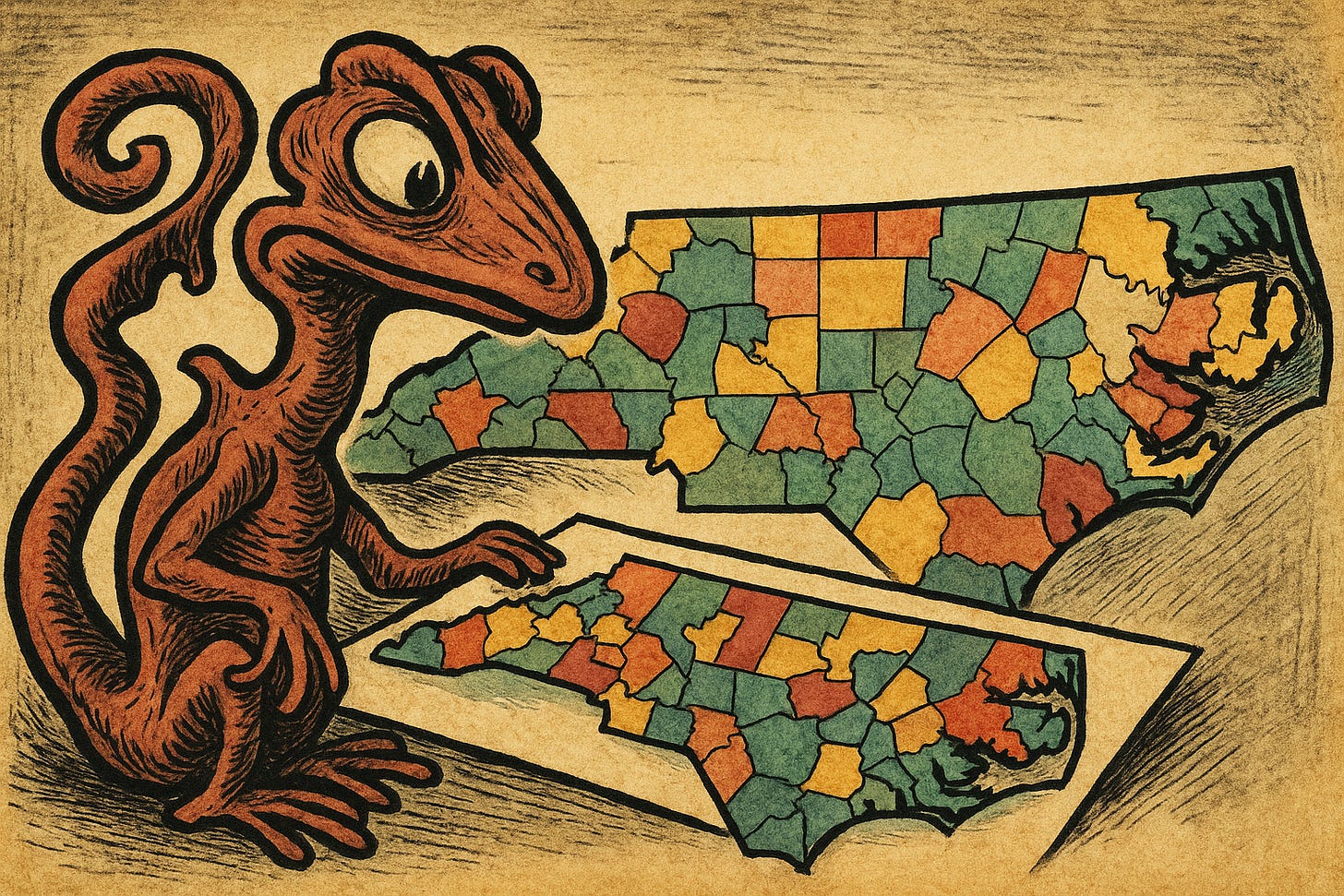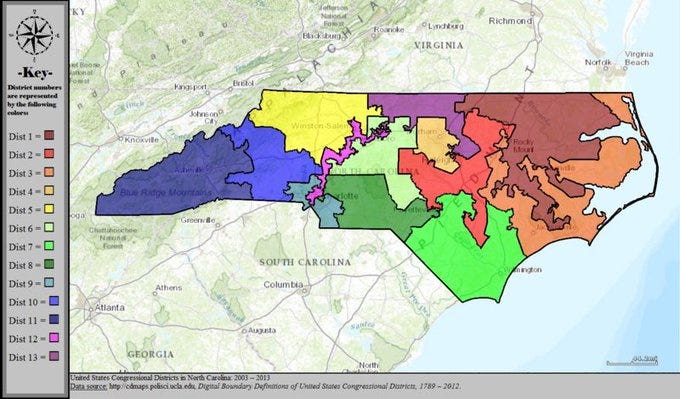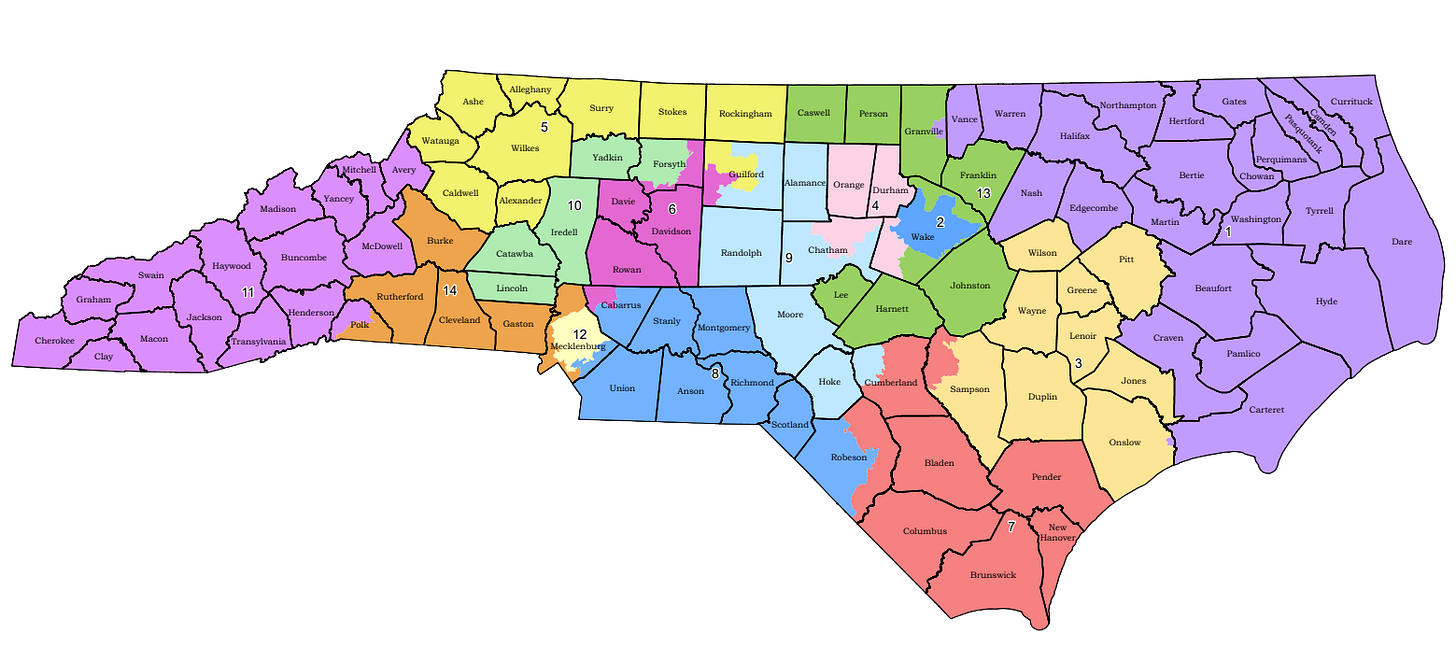What is a gerrymander? Not “a map that disappoints Democrats”
I won't defend the process that made it, but I will defend the new Congressional map itself
North Carolina officially has new congressional districts, and chances are they’ll deliver an additional Republican to the U.S. House. That was the goal, and mapmakers managed it without too many weird contortions.
I still don’t think the precedent this whole exercise sets is a good one. But the map is not an “extreme gerrymander,” as Democrats tend to describe it, and that’s worth explaining.
The argument is made most coherently by Carolina Forward, a left-wing activist organization I’ve written about many times. I appreciate their approach, even when I disagree.
Their distilled claim is simple: North Carolina is roughly 50/50 in statewide votes, so why should Republicans hold 11 of 14 seats?
That’s the wrong way to think about representation. We don’t elect an at-large, proportional slate. We elect people from places.
If what you really want is seats assigned by statewide vote share, go move to Belgium or Finland. We do districts here in America.
That argument is intellectually dishonest
The reality is that Democrats are intensely concentrated in a handful of big metros. Republicans are more dispersed. In that landscape, a GOP advantage is largely unavoidable unless you slice those cities into ribbons — the very “insane” gerrymander everyone claims to oppose.
A quick exchange on X that made the point. A Carolina Forward staffer posted the new plan and called it “the most gerrymandered congressional map this state has ever seen.”
Debates like this always make me want to pull out the book of Ecclesiastes: “What has been is what will be, and what has been done is what will be done; there is nothing new under the sun.”
I responded with the last map Democrats drew (see below).
The reply was that Republicans did pretty well under that one. Sure, but that actually makes my point.
The mark of a good map is not the outcome, it’s whether the shapes make sense in the real world. If they do, then the outcome is a product of how North Carolina actually lives, not of cartographic mischief.
The maps that they cite as good maps look absolutely hideous, but they engineer an outcome that they prefer: Giving Democrats the best chance of victory.
Really, that argument is not any different from what Republicans might say to defend their maps. It’s all about engineering outcomes. You just disagree with the outcome.
So what is a gerrymander, properly understood?
Under their definition, a gerrymander simply means “a map that disappoints Democrats.” That’s obviously wrong.
A gerrymander really means a map that tortures geography and fractures real places in order to create an outcome in that particular district that would not exist in any rational world. The original gerrymander was infamous because the shape insulted common sense.
A disparity does not necessarily mean discrimination. And it is not the mapmakers’ fault that Democrats are popular in a small number of counties and far less so elsewhere.
Was this map drawn with partisan awareness? Of course. Both parties draw to win when they hold the pen.
But the better question is whether the shapes violate geographic representation to get there. On that test, most of this plan holds up. You can make a fair case that Guilford County took some creative surgery1. But step back and look at the rest.
The shapes are legible, the county logic is recognizable, and the much-debated changes in the east — Districts 1 and 3 — are emphatically not a gerrymander. They read like coherent regions, not spaghetti.
If “fair” means the delegation must match the statewide vote, then geography itself becomes suspect.
The better question is simple: Can a normal person trace these lines on a paper map and recognize the communities on either side? If the answer is yes, you can dislike the partisan tilt and still admit it isn’t an extreme gerrymander.
I would have more respect for people who disagree with the maps saying that these districts don’t represent actual communities, that they’re pulling in people from all sorts of different areas. But I haven’t heard that a single time.
In a state that elects people from places, lines that respect real places are the standard. Outcomes will rise and fall with the voters. That’s representative government.
Quick hits
My editor over at the McClatchy newspapers asked me for my take on the “No Kings” protests from last weekend. My take: If this means that normal people are retaking the left and reclaiming the flag, the country is better for it. Read the column here, free with gift link: ‘No Kings’ protests are a win for conservatism
I also had a great chat with Don Brown last week. You can see the highlights in the article below, or the full interview here on my YouTube channel. Worth noting: I like Don, but this does not constitute an endorsement. I’d love to talk to Michael Whatley, too, but his campaign hasn’t reached out to me at all. Anyway, I’d love to do this format more often, so let me know if you’re interested.
At a premium
Important reads
Pressure mounts on NC Democrat Brockman to resign following sex charges (WRAL)
Lynx Blue Line ridership falls 10% after Zarutska murder (WFAE)
The left misreads the nation’s new reality (Carolina Journal)
Top spenders on social media last week
Question of the week
When the maps first came out, I polled my premium subscribers about which version they liked better — the old maps or the new maps. It was closer than I thought it would be. 58% said the new maps, with 42% preferring the old ones. Great reminder to go become a premium subscriber.
This week, I’ll ask this.
A lot of people will point to District 13 as a bad gerrymander, but I actually think it’s a pretty good district. That area represents suburban and exurban Raleigh, which is a legit constituency.






The difference is the sorted nature of the parties. The Dems ruled NC (save a few govs from the Wilmington coup of 1898 until 1994 when the young blue dogs switched. The Dem Senate leadership in 1991-92 included Howard Lee and Wendell Murphy. The split of R/D is more impt for representation than it was when Dems east of I-95 were more conservative than Reps in the triad